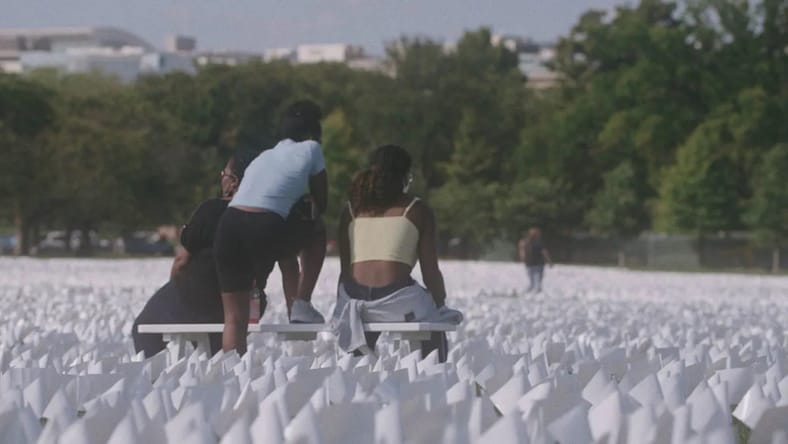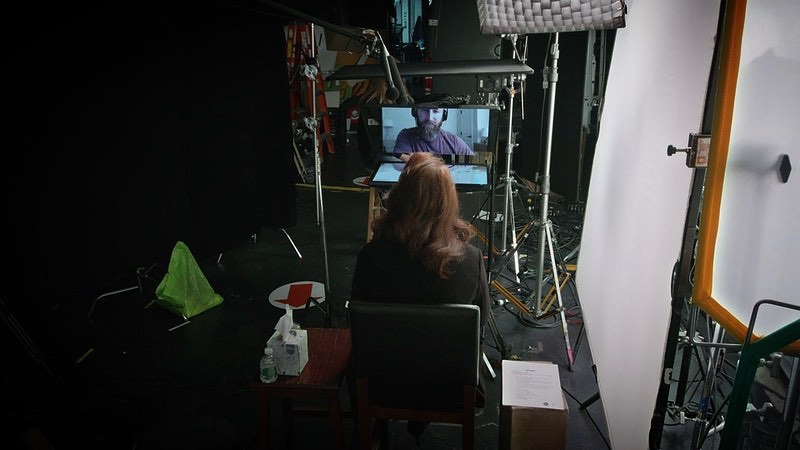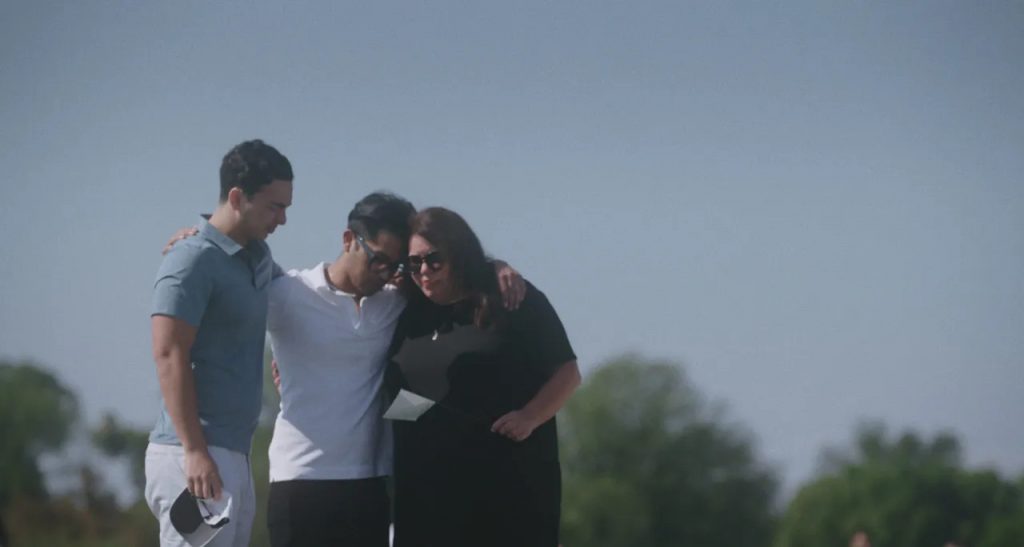
At the height of the COVID pandemic, many understandably sought escapist art, to retreat from the bombardment of bleak stories that pervaded the news cycle. Moviemakers Chandler Clarke and Jamie Meltzer went another way — throwing themselves headfirst into the crisis to make movies about its devastating effects and its unlikely heroes.
Their covid movies are starkly different. Clarke’s All in My Power is a documentary feature fueled by in-depth conversations with health care workers on the frontlines. And Meltzer’s “Not Even For a Moment Do Things Stand Still” is a doc short that favors quiet observation of human loss over narrative intervention. But both inevitably faced the same challenge: In an age of COVID burnout, how can a moviemaker tell a story about the virus that audiences won’t immediately tune out?
Here, Clarke and Meltzer share a conversation on why they made COVID movies in the first place, how they made them under extraordinary circumstances, and why they believe these stories will endure after COVID fatigue has faded away.
Chandler Clarke: After New York recorded its first COVID case on March 1, 2020, everything changed.
And on a personal level, work ceased — as did the entire production world. I was struggling, but happened to connect with long-time friend and colleague Bryan Brousseau, co-owner of storytelling collective HSC.tv. He was hustling to keep his production business afloat and his staff busy, which included capturing once-in-a-lifetime footage of New York City empty — a ghost town, like some post-apocalyptic film. He told me that if I had any ideas, I should share them. And when considering the footage his team had been capturing, I immediately had an idea.
That’s how All In My Power began.
Jamie Meltzer: “Not Even For a Moment Do Things Stand Still” began when I was invited by artist Suzanne Brennan Firstenberg to document her installation: In America: Remember. A sea of white flags was planted on the National Mall, with each flag representing one person who had died from COVID-19 in America.
We all have some awareness of the death count from COVID, but we’ve grown numb to this massive and growing number.
Clarke: Even in the age of 24/7 media, the barrage of COVID coverage was astounding. Everywhere you turned, you’d hear about the terrible conditions and the mounting death toll. But for one reason or another, the news almost desensitized me to this horror.
Meltzer: It’s nearly impossible to connect with or comprehend. This became a conceptual problem in our filmmaking: How to overcome our desire to ignore the massive scope of the pandemic? How to get beyond the fatigue each of us experiences in relation to the pandemic?

Behind the scenes of All in My Power
Clarke: The world had become oversaturated with COVID content. Making a serious documentary about a pandemic to be released in the middle of a pandemic is a tall order.
One way we sought to differentiate the film from other COVID-centric content was with a unique approach to interviews. We conducted interviews with our subjects in a space that was free of distractions, in abidance with state quarantine standards, and allowed our subjects to speak freely and comfortably about sensitive issues.
And the interview approach HSC.tv developed was a marvel in and of itself: a contact-free set, controlled remotely from the second floor of their Queens office. We’d prep the set — first disinfecting it, then vacating and allowing the talent to enter on their own, guided by a single technician who communicated via intercom. We controlled focus, camera, and the lights remotely, and used an “interrotron”-inspired approach, with the help of Zoom.
Also read: We Feed People: Ron Howard and Nat Geo Doc Spotlights World Central Kitchen’s José Andrés
At first, I was worried that losing our human connection with our subjects in the remote environment would be a detriment to my interview approach, but I was wrong. I was truly locked in, one-on-one with each subject for two-plus hours, and eye-to-eye with the cast — unable to hide behind cameras or crew. It was more intimate than any in-person interviews I’ve conducted in my career. It was an unforgettable experience that added depth to all of our cast’s answers.
Meltzer: For our film, we didn’t want to use any interviews or explanatory narration. There are many moments in the film where the audience doesn’t know the details of who has been lost to COVID. In withholding some specifics about each loss, I hoped to draw the viewer closer — to ask them to hold space for each mourner, to pay even closer attention.
Clarke: Being entrusted to tell such personal stories is a great responsibility. I took my film very personally. Every decision weighed on me.
The first script I provided our editor, Pier, was 44 pages long, single-spaced. I’m sure the post team loved seeing that. I was so protective over our cast’s stories that I felt it all needed to make final cut. But bit by bit, week by week, you begin to understand that what you cut doesn’t affect the stories’ integrity — that you can maintain their credibility and heart while getting to the point more efficiently. Through the process of what Pier calls “ruthless editing,” we kept the most powerful moments of 12 stories — all unique to each individual, but with common themes of fear, devastation, pride, and hope.
Meltzer: We found that one of the most striking aspects of the art installation was the way the flags moved in the wind. Both the individual waves of each flag and the waves of all the flags together created their own unique sounds. In editing, we developed this soundscape even more: Using natural sounds we recorded on site and some sounds we recorded in post, we built a sound mix that was focused on both the 700,000-plus flags together and the “one” that waves on its own. The sound of all the flags waving at once helped convey how individual losses contribute to a larger landscape of collective loss.
And visually, our film didn’t end up using any of the wide shots we filmed. We opted to keep viewers close to what’s on screen. We didn’t want audiences to feel distanced from our subjects, or to sit through the film in discomfort. And there are no edges of the installation seen in the frames, in order to create that sense of immersion.

A scene from “Now Even For a Moment Does Time Stand Still”
Clarke: We felt that creating an apolitical, raw, first-hand account of what it was like for healthcare professionals during the height of the COVID pandemic had the potential to serve as a time capsule far into the future. So, I never wanted to impart my personal views on our subjects. But I certainly wanted our creative approach to shine through. I don’t believe you can make a documentary that’s agnostic to your own views. The questions you ask, the way you juxtapose edits, your choices of the film’s title, music, color grade… it’s all to achieve your desired effect when telling a story.
Meltzer: For our project, our interactions with the folks placing flags in the installation were limited. We approached them as they were filling out a flag to a loved one who passed, and obtained permission to film with them. These moments only lasted a few minutes in most cases, but they revealed an extraordinary depth of emotion. The filming process was challenging, being so close to so much pain and loss, but that only increased our crew’s commitment to bringing these stories to light.
Clarke: We began production at the height of the pandemic — when PPE was scarce, ventilators were nowhere to be found, hospitals were beyond capacity, HCPs were striking, the death toll was mounting, and hospitals had strict protocol on who could talk to the media and what could be said. Living with the virus was unsettling, and still, our 12 participants took time out of their days to day to speak with us. That meant a lot.
Multiple times throughout production, I said, “If the healthcare professionals who helped create this film are proud of the documentary, then we’ve done our job successfully.” Luckily, everyone who participated has had positive things to say, and that has made our efforts worthwhile.
All in My Power is now available to stream on Apple TV, Prime Video, and iTunes.
“Not Even For a Moment Do Things Stand Still” had its world premiere at SXSW 2022, and is now available to watch as part of The New York Times’ Op-Docs series. Main image: a still from “Not Even For a Moment Do Things Stand Still”
Share:

